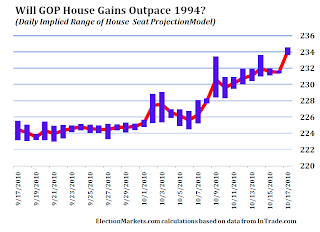Today's midpoint estimate -- 234 seats or an increase of 57 seats from the 177 Republicans held after the 2008 elections. Additionally, our model gives Republicans an 86.5% chance of taking control of the House of Representatives. Republican prospects have experienced a generally uninterupted march higher over the past two weeks. The question is whether or not this momentum will continue for another 15 days.
As the chart to the left shows, it isn't simply the projected gains that have steadily advanced, but the probability of House control as well.
The situation isn't quite as sanquine for Republicans on the Senate side of the ledger. Democratic prospects have been improving over the past week. As the Daily Snapshot illustrates, our micro model projects 47.8 Republican seats and the macro model projects 48.8 seats.
Prospects for Republican control are rated below 20% on both of our models. It is important to remember that the micro version of our model is a straight statistical simulation that assumes that each of the races operates as an independent event. In a trend election that will be less true than in a run of the mill election year.
The difference in the estimates of our macro model and micro model are based in part on the perception of what the trend effect will be AND the market's view of what seats are actually in play. As the next chart shows, the trend on our micro model's estimate has turned more favorable to Democrats over the past week.
While Republican prospects for Senate control is not "great" at this point in time, our models' projections of 48 or 49 seats -- representing gains of 7 or 8 seats is not insignificant.
As we have noted in previous posts, the battle for the Senate seems focused on six seats -- California, Colorado, Illinois, Nevada, Washington, and Wisconsin.
If Repbulicans were to capture all of the seats in which they are above 50% in our midpoint estimates, they would end up with 49 seats in the Senate, slightly above both of our statistical model estimates. However, readers should be on the lookout for significant volatility over the course of the next week. Recent polling has given widely varying pictures of the individual races, particularly in Washington and West Virginia. The other race on our "list of six" that may provide some entertainment is in California where recent polling has suggested a race where Senator Barbara Boxer is only narrowly ahead of former HP CEO Carly Fiorina. The next chart shows just how volatile the InTrade markets have been in the six races since the beginning of September.
Note the volatility over the past month in the Washington and West Virginia races. The data would suggest future volatility is more likley than not as we approach election day.
For those who are into charts, additional charts follow that show the probability distribution from our micro model's Senate projections on both a cumulative and an individual basis. Both charts show results for today compared with September 1 -- before Senator Murkowski's announcement that she would run as a write-in candidate and before Christine O'Donnell's victory in the Delaware Republican primary. Readers will note that Republican prospects are significantly better than on September 1. Also included below is our chart showing trends in the InTrade contracts for Senate control.









